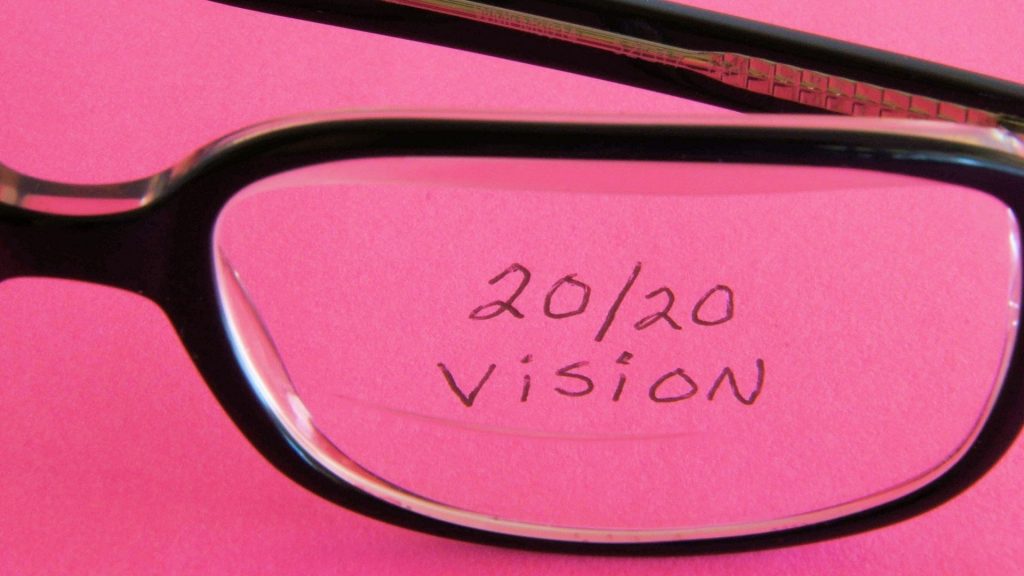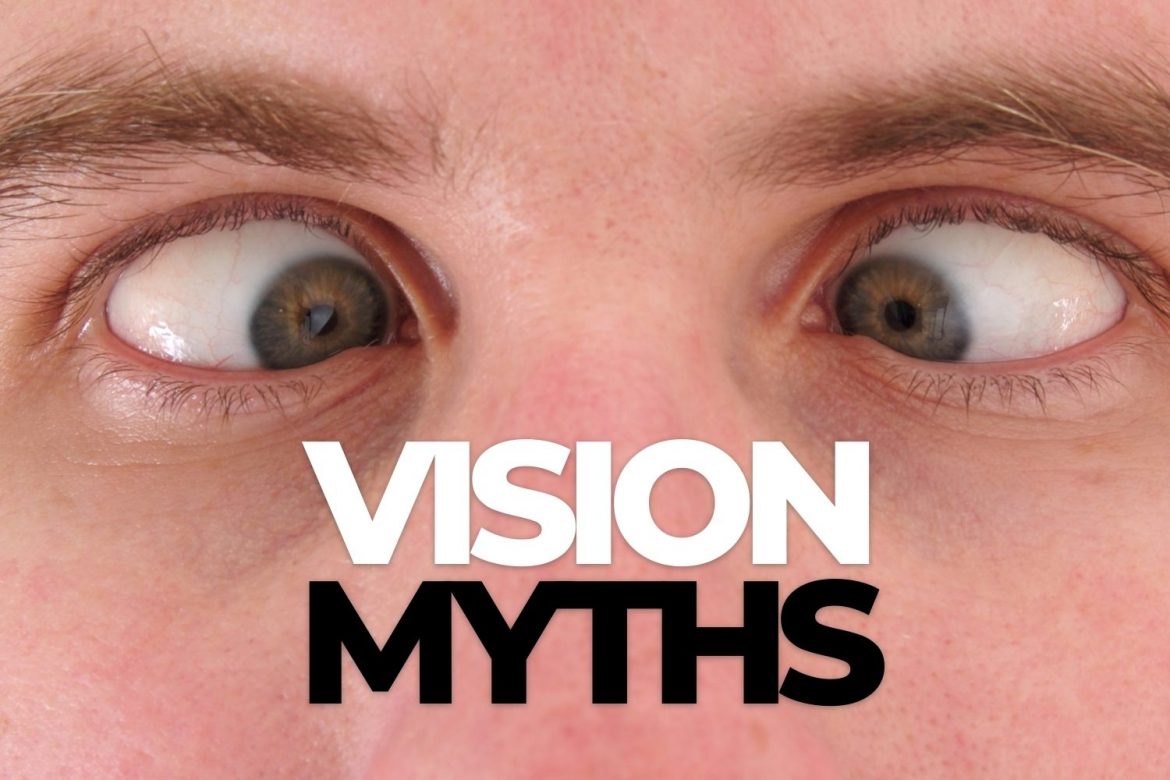![]()
“Don’t sit too close to the television. You’ll go blind!”… “Turn on the light when you read. If you don’t, you’ll go blind!”… “Don’t cross your eyes, they’ll stay that way and you’ll go blind!”
These classic bits of eye health wisdom from my dear mother still ring clearly in my ears.
Unfortunately, I sat way too close to the tube, I read in the dark more often than not, and my friends and I probably spent a collective week of our lives looking at each other through crossed eyes… and guess what? My eyes didn’t stay crossed and, believe it or not, I didn’t go blind!
Fortunately, none of these timeless words of eye health advice shared for years by millions of mothers around the world have turned out to be true.
So where did these crazy myths about vision—and the many others we’ve heard over the years—come from? And more importantly: are any of them true or are they all wise tales and myths?
Here are the 10 most common eye-related health myths and my attempt to use facts and research to effectively debunk each. I’ll start with the three mentioned above.
Myth #1: Don’t sit too close to the TV or you’ll go blind
While you shouldn’t sit unnecessarily close to a television screen if you don’t absolutely need to, doing so is not going to harm your vision or make you go blind.
However, sitting close to any type of screen (television, computer, tablet, or mobile device) can cause your eyes to become strained and tired and contribute to headaches.
For many, sitting too close or holding electronic devices too close to their eyes could be an indication of myopia (nearsightedness), a condition that requires an eye exam and more often than not, prescription glasses and/or contact lenses.
Myth #2: Reading in the dark hurts your eyes
Like sitting too close to a television will not cause you to go blind, reading in the dark or in low light also will not damage your eyes or contribute to blindness.
Think about it, before the invention of electricity, the only way people were able to read or write at night was by candlelight! Reading in the dark isn’t ideal, but it isn’t harmful.
In most cases, when compared to reading in bright light, your eyes will tire faster than normal in low light. Eye fatigue, or eye strain, is often characterized by headaches, blurred vision, and sore, watery, itchy eyes. While eye strain is uncomfortable and annoying, the condition will not cause permanent damage to your vision.
Myth #3: Crossing your eyes will make them stay that way forever
The human eye contains six muscles specifically designed to move your eyes up and down, side to side, and to help rotate the eyes in a circular motion. Just like using your biceps or triceps to move and hold your arm a specific way before returning to a resting position, the muscles in your eyes are designed to assist with movement in a way that doesn’t result in them being forced to remain permanently in that position—including when you cross your eyes.
Eyes can become crossed, but this condition is most often a result of specific health conditions, unaddressed vision issues, or damage that has occurred to the muscles or nerves in the eye—not because you decided to cross your eyes.
Myth #4: Eating carrots improves your vision

Eating a diet rich in fresh fruits and vegetables is one of the keys to supporting overall health and wellness. However, eating an excessive amount of one specific fruit or vegetable for one specific reason is not typically an effective way to address a specific condition. This is especially true of eating carrots to improve your vision.
While it’s true that carrots are rich in vitamin A, and that vitamin A supports healthy vision, there is no evidence that specifically eating carrots in an effort to improve your vision will help.
Vitamin A deficiency has been identified as a leading cause of blindness in children, but this tends not to be the case in developed countries. Additionally, you typically require between 700 and 900 mcg of vitamin A each day, an amount that is easily attainable through a normal diet.
For the sake of comparison, a serving of sweet potato, squash, or kale all has 100% of the recommended daily value (RDV) of vitamin A, while one carrot has just over 40% of the RDV.
Other quality sources of vitamin A include spinach, romaine lettuce, mango, cantaloupe, and salmon.
Myth #5: Specific eye exercise can improve your vision
Although exercise helps strengthen the muscles in your body, including the muscles used to move your eyes, eye exercises have not been shown to improve vision or prevent the need for contact lenses and/or glasses.
Specific eye exercises have, however, been shown to be helpful for addressing specific eye problems, including convergence insufficiency (a condition that occurs when the eyes aren’t working together to focus), amblyopia (lazy eye), and in helping to prevent digital strain.
Myth #6: 20-20 vision means your eyes are perfectly healthy

20/20 vision means you have good central vision. However, central vision is only one type of vision. In addition to central vision, the eyes are used for peripheral, or side, vision, night vision, and color vision, all of which are capable of changing over time.
Vision and healthy eyes are also different in that vision is how you see while eye health pertains to the health and function of your eyes. In their early stages, medical conditions like glaucoma and macular degeneration might not affect central vision, but slowly damage parts of your inner eye over time. It is common not to notice the progression of these diseases through central vision, at least until they interfere in their later, more advanced stages.
Myth #7: Wearing glasses (or contacts) all the time ruins your vision
Obviously, the purpose of glasses and contact lenses is to improve your vision, but some people believe wearing glasses all the time can actually ruin your vision.
Fortunately, the fact that glasses and contacts do not make your eyes worse has been well documented. Reading fine print or working with small objects often cause your eyes to feel tired and strained, but these activities don’t damage your vision or cause your eyes to “wear out.”
While your vision might get worse as you age, it’s not because you wear glasses or contact lenses.
You certainly have more of a chance of experiencing vision-related changes as you get older, but aging by itself is not associated with losing your vision—especially since many age-related vision issues are now able to be treated and prevented.
Two of the most common age-related vision issues—presbyopia and cataracts—when left untreated, can lead to near-complete vision loss. However, when identified and monitored as part of an annual eye exam, both conditions can be treated to restore clear vision. The same is true for more serious conditions, like glaucoma or macular degeneration. While neither of these can be completely cured, early detection allows for both conditions to be treated to slow—and even prevent—related vision loss.
Myth #9: Contact lenses are dangerous and can lost behind the eye
The human eye is covered by a membrane known as the conjunctiva. This membrane connects your eye to the inside of your eyelid, making it impossible for anything —including a contact lens—from moving behind the eye.
Myth #10: You don’t need regular eye exams if your vision hasn’t changed
This is probably the most important myth to debunk. Just because your vision hasn’t changed, or because you don’t think it has, doesn’t mean your eyes are not changing. The progression of many of the most damaging eye conditions—including macular degeneration, glaucoma, and diabetic retinopathy—tends to happen slowly over time. These conditions can be slowed, but only when detected as part of a routine eye exam.
The American Optometric Association recommends an eye exam every two years for people under 65 and an annual exam for those age 65 and over.

